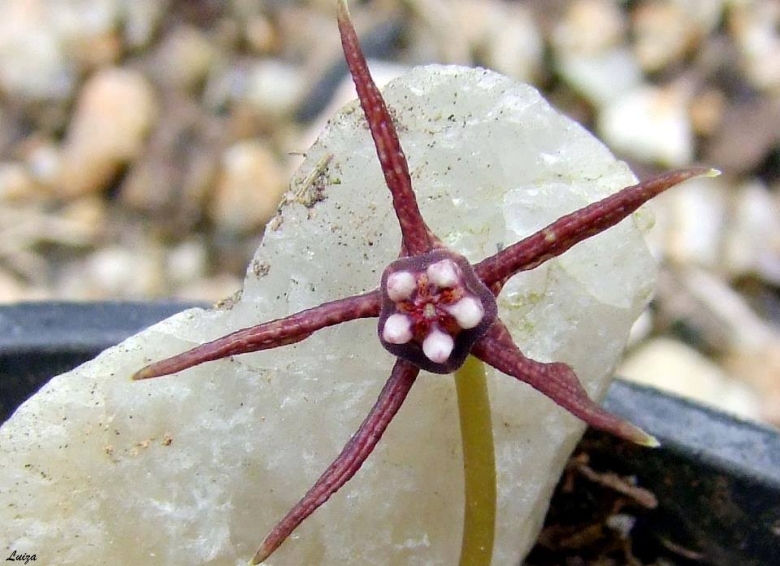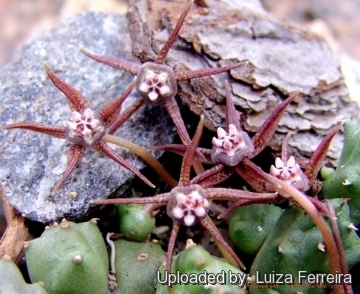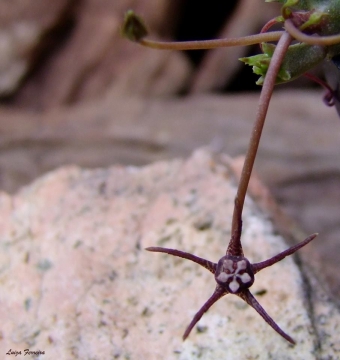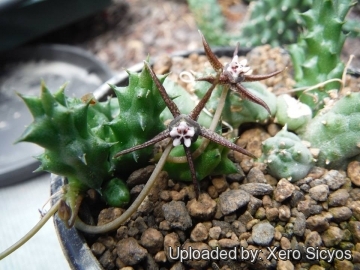




Your support is critical to our success.

Origin and Habitat: Duvalia angustilobaSN|30444]]SN|30444]] has a restricted distribution in Western Cape and Eastern Cape (Great Karoo), Republic of South Africa.
Altitude range: 800-1700 metres above sea level.
Habitat and ecology: It grows on sand.
Synonyms:
- Duvalia angustiloba N.E.Br.
Description: Duvalia angustilobaSN|30444]]SN|30444]] is a densely tufted perennial-succulent with distinct, five-pointed, starfish-like flowers of elaborate design and beauty. Its dark brown flowers, the tiniest in the genus, have curious lobes folded lengthwise (replicate) into narrow vertical plates. The corona at the centre of the flower is obtusely 5-angled and reduced to a mere margin and together with the pure white inner corona resembling a miniature crown. D. angustiloba is self-sterile, but interfertile with most other species.
Stems: (8-)12-25(-30) mm long, (8-)12-18(-20) mm thick, subglobose, oblong, or ovoid-cylindrical, obtusely 4–5-angled, dull green to greyish-green; angles tuberculate-dentate.
Leaves: Rudimentary approx 2 mm long, very sharply pointed.
Inflorescence: Dichasia with 5–20 or more procumbent flowers together in gradually developed cymes or fascicles, often on stout peduncles, at about the middle of the younger stems. Pedicels (20-)25-35(-40) mm long, rather slender, glabrous.
Flowers: Sepals 2-3 mm long, reflexed, lanceolate-subulate. Corolla very acutely conical and 5-grooved in bud, when expanded (15-)18-22(-25) mm in diameter, very delicate, spider-like, chocolate-brown (rarely light green spotted brown), glabrous, with an exceedingly minute ciliation at the base of the lobes, only visible under a lens, scentless or with slight foetid odour. Corolla with the disk raised into a very narrow tube-like rim, or annulus , supporting the corona. Annulus round to 5-angled, 35-45 mm in diameter, not much raised above the level of the lobes (0.4-0.8 mm) slightly constricted at the base, hairy (to papillate).Corolla lobes, free, (6-)8-9(-10) mm long, horizontally spreading, very narrowly linear-lanceolate, folded lengthwise (replicate) from base to apex into vertical acute, vertical plates about 2-4 mm in depth at the base, with an impressed line along the fold, margins glabrous or hairy (to papillate) at the base, hairs 0.05 - 0.1 mm long. Outer corona c. 3 mm in diameter, white (spotted maroon), in one piece, disk-like, obtusely 5-angled reduced to a mere margin resting on rim of the raised annulus and closing the spurious tube formed by it, and together with the inner corona resembling a miniature crown, pure white at first, becoming dirty white in a few days, the incumbent tips of the inner leaf-like corona-lobes very acute 1.2-1.5 x 1.5 mm. Pollinia 0.27 x 0.18 mm, translator wings ± 0.22 mm long.
Fruits (paired follicles): 8 -10 cm long.
Seeds: 4-5 mm long, 2.5-3 mm thick.
Bibliography: Major references and further lectures:
1) N. E. Brown “Flora Capensis” Vol 4, 1909
2) Bruyns, P.V. “Stapeliads of southern Africa and Madagascar” (Vol. 1, pp. 1-330). Umdaus Press, Pretoria. 2005
3) Focke Albers, Ulrich Meve “Illustrated Handbook of Succulent Plants: Asclepiadaceae: Asclepiadaceae” Volume 4 Springer, 2002
4) Ulrich Meve, Focke Albers “The species concept in Duvalia (Asclepiadaceae): A preliminary revision of the genus” In: Mitteilungen aus dem Institut für Allgemeine Botanik in Hamburg. 23: 595–604.1990.
5) Meve, U. 1997. "The genus Duvalia (Stapelieae)", 130 pp, Springer, Wien.
6) M.B.Bayer “Duvalias” in Veld & Flora, Volumi 69-71 Botanical Society of South Africa, 1983

Duvalia angustiloba JJS 017- RSA Photo by: Luiza Ferreira

Duvalia angustiloba Photo by: Luiza Ferreira

Duvalia angustiloba Photo by: Xero Sicyos
The gallery now contains thousands of pictures, however it is possible to do even more. We are, of course, seeking photos of species not yet shown in the gallery but not only that, we are also looking for better pictures than those already present. Read More...
Cultivation and Propagation: Duvalia angustilobaSN|30444]]SN|30444]] is a tiny, but easy obliging blooming plant when mature, that it is happy in any average succulent house.
Potting:Since roots are quite shallow, use a soft and incoherent cactus mix or add extra perlite or pumice to regular soil potting soil, and clay pots help the plants to dry out between watering.
Waterings: Duvalia require moderately watering through the growing season but enjoy plenty of water and some fertiliser in hot weather, this helps them to flower freely. Water more sparingly in winter according to temperatures. But, as with most asclepiads, it is unwise to leave them wet in cold weather.
Fertilization: Fertilizers for succulent plants must be rich in potassium, but poor in nitrogen, to avoid the plants from developing excess vegetation, which is easily attacked by fungal diseases.
Sun Exposure: As with many succulents, they prefer to grow in the light shade of scrubby shrubs or between rocks where they get some shade during the day. In summer it is advisable to position this plant in a partially shady place, where it is exposed to direct sunlight only during the coolest hours of the day.
Hardiness: These plants don't like cold weather, therefore in the Spring it is best to set them outside only when the temperatures are above 15°C. Can endure temperatures below 5°C for short period, but only if the soil stays completely dry.
Pest and diseases: Duvalias species vary in their susceptibility to rotting, but are generally fairly easy to grow, especially if kept pest-free. They are very susceptible to stem and root mealy bugs, and damage from these may well initiate fungal attack. If you do have problems with a stem or with basal rotting, you can reliably isolate the healthy parts, dry them off, and re-root them in moist compost.
Cultural Practices: Re-pot every 2 years.
Propagation: Easiest with stem cuttings. Allow cuttings to dry a day before planting. Stems must be laid (Not buried) on gritty compost and will then root from the underside of the stems. It can also be increased from seeds sowing in spring in moist, sandy peat moss. Barely cover seeds. Seeds germinate quickly.
| Your Actions | |
|---|---|
| Back to Duvalia index | |
| Back to Asclepiadaceae index | |
 |
Back to Succulents Encyclopedia index |
Privacy stantement - Terms and conditions - How to cite - About us - Feedback - Donate




